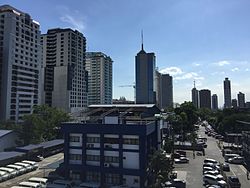San Juan, Manila
| San Juan | ||
|---|---|---|
| Highly-Urbanized City | ||
|
Dakilang Lungsód ng San Juan (Great City of San Juan) |
||

Skyscrapers along Annapolis Street in Greenhills
|
||
|
||
| Nickname(s): Heart of Metro Manila; Home of Philippine Presidents; Tiangge Capital of the Philippines | ||
| Motto: Todo Asenso, San Juan! ("Progress, San Juan!") Diwa ng 1896 ("Spirit of 1896") |
||
 Location within Metro Manila |
||
| Location within the Philippines | ||
| Coordinates: 14°36′N 121°02′E / 14.6°N 121.03°ECoordinates: 14°36′N 121°02′E / 14.6°N 121.03°E | ||
| Country | Philippines | |
| Region | National Capital Region | |
| Districts | Lone District of San Juan | |
| Incorporated | 1623 (town) | |
| Incorporated | 17 June 2007 (cityhood) | |
| Barangays | 21 | |
| Government | ||
| • Mayor | Guia Gomez (Partido Magdiwang-UNA) | |
| • Vice Mayor | Janella Marie V. Ejército (Partido Magdiwang) | |
| • Representative | Ronaldo Zamora (PDP-Laban) | |
| • Sangguniang Panlungsod |
Councilors
|
|
| Area | ||
| • Total | 5.87 km2 (2.27 sq mi) | |
| Elevation | 17.0 m (55.8 ft) | |
| Population (2015 census) | ||
| • Total | 122,180 | |
| • Density | 21,000/km2 (54,000/sq mi) | |
| Demonym(s) | San Juaneño (m), San Juaneña (f) | |
| Time zone | PST (UTC+8) | |
| Zip code | 1500–1504 | |
| Area code | +63 (0)02 | |
| Website | www |
|
San Juan is the smallest city in the Philippines located east of Manila. It is historically known as the site of the first battle of the Katipunan, the organization which led the 1896 Philippine Revolution against the Spanish Empire. It is a part of Metro Manila, the National Capital Region of the Philippines. According to the 2015 census, it has a population of 122,180.
"San Juan City" is a contraction of the city's traditional name of San Juan del Monte (English: "Saint John of the Mountain"). As with numerous other places in the Philippines, the name combines a patron saint and a toponym; in this case Saint John the Baptist with the locale's hilly terrain and relatively higher elevation compared to surrounding areas.
The city's official name is Dakilang Lungsód ng San Juan (English: "Great City of San Juan").
During the pre-Hispanic period, the area of what is now San Juan was a part of the Kingdom of Namayan, whose last recorded rulers were King Lacantagean and his consort, Bouan. After the kingdom and other polities in the islands were absorbed into the Spanish Crown in the late 16th century, the realm of Namayan was christened Santa Ana de Sapa. The present area of San Juan was meanwhile re-classified as a barrio, becoming a small encomienda by 1590.
In 1602, the Dominicans built a retreat house in the vicinity for their immediate use, where ageing or convalescing friars stayed. Later, the Order constructed a convent and stone church dedicated to the Holy Cross. To this day, the thrice-rebuilt Santuario del Santo Cristo stands on the same site, adjacent to Aquinas School and Dominican College.
...
Wikipedia


